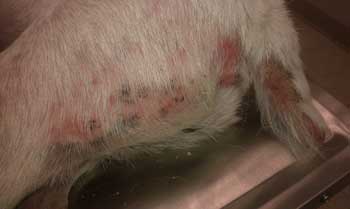First Aid for Pets: Be prepared!
Many have a first aid kit available as a mini-emergency station in their homes. Keeping a kit in your car is especially handy when you are on the road. But what about your pet?
The American Red Cross has maintained a message of preparedness for those unplanned situations that may occur. With the large number of pet owners, it is a good idea to keep basic first aid supplies for your four-legged friend.
Fully assembled pet first aid kits can be purchased at larger pet supply stores or on-line. The American Red Cross website provides an extensive list of items that could be included in a kit that you can assemble yourself. More information is in Pet First Aid by Barbara Mammato, DVM, MPH, a handbook sponsored by the American Red Cross and The Humane Society of the United States.
To expand on your preparedness, some chapters of the Red Cross offer classes in First Aid and Animal CPR. From the Animal Kennel Club website: “The Red Cross four hour Pet First Aid Training course utilizes mannequins to learn the correct skills for small-medium and large dog CPR as well as how to perform CPR on cats. The instructor will demonstrate CPR, rescue breathing and how to care for choking emergencies. You will learn how to splint broken bones; control bleeding and emergency care for poisoning and bloat/torsion. How to deal with burns and other common emergencies and illnesses are also covered in this course on Pet First Aid.”
There is no substitute for the professional care of a veterinarian, but having a first aid kit and knowledge of basic medical care should an emergency arise could prove to be beneficial.
Cats Flipping Their Wigs

If your cat needs a fashion update, there’s a wig for that. Yes, a wig.
Kitty Wigs ® is an on-line site (www.kittywigs.com) that currently offers four choices of feline wigs ($65) to get your kitty to be, well, the cat’s meow.
If you love the look, but your Miss Kitty is not so thrilled about it, not to worry, because you can get a peek of some of the feline fashionistas collected in a book also available for purchase. In addition, they offer a video of models presumably on the catwalk (where else?), gift cards and more.
Photo: Courtesy of Jill Johnson

 Here are the symptoms: intense itching, scabs or crusting, reddening skin and thinning coat.
Here are the symptoms: intense itching, scabs or crusting, reddening skin and thinning coat. Some pet owners attempting to resolve the symptoms on their own usually try the food allergy route because the popular trend on Dr. Google is that grain or corn is the culprit of an itchy dog (although the protein source is usually the allergen, not the carbohydrate). In truth, if a strict and disciplined food elimination diet is followed, the results will help to eliminate or identify a food allergy. A food trial can go as long as 12 weeks, all the while as many as four generations of multiplying mites are now feeding on the canine buffet of Fido or feline smorgasbord of Fluffy!
Some pet owners attempting to resolve the symptoms on their own usually try the food allergy route because the popular trend on Dr. Google is that grain or corn is the culprit of an itchy dog (although the protein source is usually the allergen, not the carbohydrate). In truth, if a strict and disciplined food elimination diet is followed, the results will help to eliminate or identify a food allergy. A food trial can go as long as 12 weeks, all the while as many as four generations of multiplying mites are now feeding on the canine buffet of Fido or feline smorgasbord of Fluffy!